Whole Genome Sequencing Reveals Antimicrobial Resistance and Virulence Genes of Both Pathogenic and Non-Pathogenic B. cereus Group Isolates from Foodstuffs in Thailand
Abstract
1. Introduction
2. Results
2.1. Phylogenetic Analysis of B. cereus Group Isolates
2.2. Subsystem Categorization
2.3. AMR Gene Analysis
2.4. Virulence Factor Gene Analysis
2.5. Biofilm-Associated Gene Analysis
3. Discussion
4. Materials and Methods
4.1. Bacterial Strains
4.2. DNA Extraction and WGS
4.3. Genome Assembly and Annotation
4.4. Phylogenetic Trees
4.5. Subsystem Categorization
4.6. Nucleotide Sequence Accession Numbers
Author Contributions
Funding
Institutional Review Board Statement
Informed Consent Statement
Data Availability Statement
Conflicts of Interest
References
- Kolstø, A.B.; Tourasse, N.J.; Økstad, O.A. What sets Bacillus anthracis apart from other Bacillus species? Annu. Rev. Microbiol. 2009, 63, 451–476. [Google Scholar] [CrossRef]
- Ehling-Schulz, M.; Lereclus, D.; Koehler, T.M. The Bacillus cereus Group: Bacillus Species with Pathogenic Potential. Microbiol. Spectr. 2019, 7, 10–1128. [Google Scholar] [CrossRef]
- Nakamura, L.K. Bacillus pseudomycoides sp. nov. Int. J. Syst. Bacteriol. 1998, 48 Pt 3, 1031–1035. [Google Scholar] [CrossRef]
- Lechner, S.; Mayr, R.; Francis, K.P.; Prüss, B.M.; Kaplan, T.; Wiessner-Gunkel, E.; Stewart, G.S.; Scherer, S. Bacillus weihenstephanensis sp. nov. is a new psychrotolerant species of the Bacillus cereus group. Int. J. Syst. Bacteriol. 1998, 48 Pt 4, 1373–1382. [Google Scholar] [CrossRef]
- Hoton, F.M.; Fornelos, N.; N’Guessan, E.; Hu, X.; Swiecicka, I.; Dierick, K.; Jääskeläinen, E.; Salkinoja-Salonen, M.; Mahillon, J. Family portrait of Bacillus cereus and Bacillus weihenstephanensis cereulide-producing strains. Environ. Microbiol. Rep. 2009, 1, 177–183. [Google Scholar] [CrossRef]
- Miller, R.A.; Beno, S.M.; Kent, D.J.; Carroll, L.M.; Martin, N.H.; Boor, K.J.; Kovac, J. Bacillus wiedmannii sp. nov., a psychrotolerant and cytotoxic Bacillus cereus group species isolated from dairy foods and dairy environments. Int. J. Syst. Evol. Microbiol. 2016, 66, 4744–4753. [Google Scholar] [CrossRef] [PubMed]
- Guinebretiere, M.H.; Auger, S.; Galleron, N.; Contzen, M.; De Sarrau, B.; De Buyser, M.L.; Lamberet, G.; Fagerlund, A.; Granum, P.E.; Lereclus, D.; et al. Bacillus cytotoxicus sp. nov. is a novel thermotolerant species of the Bacillus cereus Group occasionally associated with food poisoning. Int. J. Syst. Evol. Microbiol. 2013, 63, 31–40. [Google Scholar] [CrossRef] [PubMed]
- Liu, Y.; Lai, Q.; Göker, M.; Meier-Kolthoff, J.P.; Wang, M.; Sun, Y.; Wang, L.; Shao, Z. Genomic insights into the taxonomic status of the Bacillus cereus group. Sci. Rep. 2015, 5, 14082. [Google Scholar] [CrossRef]
- Liu, Y.; Du, J.; Lai, Q.; Zeng, R.; Ye, D.; Xu, J.; Shao, Z. Proposal of nine novel species of the Bacillus cereus group. Int. J. Syst. Evol. Microbiol. 2017, 67, 2499–2508. [Google Scholar] [CrossRef]
- Bianco, A.; Capozzi, L.; Monno, M.R.; Del Sambro, L.; Manzulli, V.; Pesole, G.; Loconsole, D.; Parisi, A. Characterization of Bacillus cereus Group Isolates From Human Bacteremia by Whole-Genome Sequencing. Front. Microbiol. 2020, 11, 599524. [Google Scholar] [CrossRef]
- Liu, X.; Wang, L.; Han, M.; Xue, Q.H.; Zhang, G.S.; Gao, J.; Sun, X. Bacillus fungorum sp. nov., a bacterium isolated from spent mushroom substrate. Int. J. Syst. Evol. Microbiol. 2020, 70, 1457–1462. [Google Scholar] [CrossRef] [PubMed]
- Goldstein, B.; Abrutyn, E. Pseudo-outbreak of Bacillus species: Related to fibreoptic bronchoscopy. J. Hosp. Infect. 1985, 6, 194–200. [Google Scholar] [CrossRef]
- Bryce, E.A.; Smith, J.A.; Tweeddale, M.; Andruschak, B.J.; Maxwell, M.R. Dissemination of Bacillus cereus in an intensive care unit. Infect. Control Hosp. Epidemiol. 1993, 14, 459–462. [Google Scholar] [CrossRef] [PubMed]
- Granum, P.E. Bacillus cereus and its toxins. Soc. Appl. Bacteriol. Symp. Ser. 1994, 23, 61s–66s. [Google Scholar] [CrossRef]
- Bottone, E.J. Bacillus cereus, a volatile human pathogen. Clin. Microbiol. Rev. 2010, 23, 382–398. [Google Scholar] [CrossRef]
- Lund, T.; Granum, P.E. Comparison of biological effect of the two different enterotoxin complexes isolated from three different strains of Bacillus cereus. Microbiology 1997, 143 Pt 10, 3329–3336. [Google Scholar] [CrossRef]
- Lund, T.; De Buyser, M.L.; Granum, P.E. A new cytotoxin from Bacillus cereus that may cause necrotic enteritis. Mol. Microbiol. 2000, 38, 254–261. [Google Scholar] [CrossRef]
- Sakai, C.; Iuchi, T.; Ishii, A.; Kumagai, K.; Takagi, T. Bacillus cereus brain abscesses occurring in a severely neutropenic patient: Successful treatment with antimicrobial agents, granulocyte colony-stimulating factor and surgical drainage. Intern. Med. 2001, 40, 654–657. [Google Scholar] [CrossRef]
- Clair, G.; Roussi, S.; Armengaud, J.; Duport, C. Expanding the known repertoire of virulence factors produced by Bacillus cereus through early secretome profiling in three redox conditions. Mol. Cell. Proteom. 2010, 9, 1486–1498. [Google Scholar] [CrossRef]
- Caro-Astorga, J.; Pérez-García, A.; de Vicente, A.; Romero, D. A genomic region involved in the formation of adhesin fibers in Bacillus cereus biofilms. Front. Microbiol. 2015, 5, 745. [Google Scholar] [CrossRef]
- McCarthy, H.; Rudkin, J.K.; Black, N.S.; Gallagher, L.; O’Neill, E.; O’Gara, J.P. Methicillin resistance and the biofilm phenotype in Staphylococcus aureus. Front. Cell. Infect. Microbiol. 2015, 5, 1. [Google Scholar] [CrossRef] [PubMed]
- Gomes, F.; Saavedra, M.J.; Henriques, M. Bovine mastitis disease/pathogenicity: Evidence of the potential role of microbial biofilms. Pathog. Dis. 2016, 74, ftw006. [Google Scholar] [CrossRef]
- Rutherford, S.T.; Bassler, B.L. Bacterial quorum sensing: Its role in virulence and possibilities for its control. Cold Spring Harb. Perspect. Med. 2012, 2, a012427. [Google Scholar] [CrossRef] [PubMed]
- Mills, E.; Sullivan, E.; Kovac, J. Comparative Analysis of Bacillus cereus Group Isolates’ Resistance Using Disk Diffusion and Broth Microdilution and the Correlation between Antimicrobial Resistance Phenotypes and Genotypes. Appl. Environ. Microbiol. 2022, 88, e0230221. [Google Scholar] [CrossRef]
- Boolchandani, M.; D’Souza, A.W.; Dantas, G. Sequencing-based methods and resources to study antimicrobial resistance. Nat. Rev. Genet. 2019, 20, 356–370. [Google Scholar] [CrossRef] [PubMed]
- Yan, F.; Yu, Y.; Gozzi, K.; Chen, Y.; Guo, J.H.; Chai, Y. Genome-Wide Investigation of Biofilm Formation in Bacillus cereus. Appl. Environ. Microbiol. 2017, 83, e00561-17. [Google Scholar] [CrossRef]
- Sornchuer, P.; Saninjuk, K.; Prathaphan, P.; Tiengtip, R.; Wattanaphansak, S. Antimicrobial Susceptibility Profile and Whole-Genome Analysis of a Strong Biofilm-Forming Bacillus sp. B87 Strain Isolated from Food. Microorganisms 2022, 10, 252. [Google Scholar] [CrossRef]
- Guinebretiere, M.H.; Thompson, F.L.; Sorokin, A.; Normand, P.; Dawyndt, P.; Ehling-Schulz, M.; Svensson, B.; Sanchis, V.; Nguyen-The, C.; Heyndrickx, M.; et al. Ecological diversification in the Bacillus cereus Group. Environ. Microbiol. 2008, 10, 851–865. [Google Scholar] [CrossRef]
- Miller, R.A.; Jian, J.; Beno, S.M.; Wiedmann, M.; Kovac, J. Intraclade Variability in Toxin Production and Cytotoxicity of Bacillus cereus Group Type Strains and Dairy-Associated Isolates. Appl. Environ. Microbiol. 2018, 84, e02479-17. [Google Scholar] [CrossRef]
- Carroll, L.M.; Cheng, R.A.; Wiedmann, M.; Kovac, J. Keeping up with the Bacillus cereus group: Taxonomy through the genomics era and beyond. Crit. Rev. Food Sci. Nutr. 2022, 62, 7677–7702. [Google Scholar] [CrossRef]
- Messelhäußer, U.; Ehling-Schulz, M. Bacillus cereus—A Multifaceted Opportunistic Pathogen. Curr. Clin. Microbiol. Rep. 2018, 5, 120–125. [Google Scholar] [CrossRef]
- Gardes, J.; Croce, O.; Christen, R. In silico analyses of primers used to detect the pathogenicity genes of Vibrio cholerae. Microbes Environ. 2012, 27, 250–256. [Google Scholar] [CrossRef]
- Paul, S.I.; Khan, S.U.; Sarkar, M.K.; Foysal, M.J.; Salam, M.A.; Rahman, M.M. Whole-Genome Sequence of Bacillus pacificus CR121, a Fish Probiotic Candidate. Microbiol. Resour. Announc. 2023, 12, e0120622. [Google Scholar] [CrossRef] [PubMed]
- Carroll, L.M.; Matle, I.; Kovac, J.; Cheng, R.A.; Wiedmann, M. Laboratory Misidentifications Resulting from Taxonomic Changes to Bacillus cereus Group Species, 2018–2022. Emerg. Infect. Dis. 2022, 28, 1877–1881. [Google Scholar] [CrossRef]
- Matson, M.J.; Anzick, S.L.; Feldmann, F.; Martens, C.A.; Drake, S.K.; Feldmann, H.; Massaquoi, M.; Chertow, D.S.; Munster, V.J. Bacillus paranthracis Isolate from Blood of Fatal Ebola Virus Disease Case. Pathogens 2020, 9, 475. [Google Scholar] [CrossRef]
- Sokolov, S.; Brovko, F.; Solonin, A.; Nikanova, D.; Fursova, K.; Artyemieva, O.; Kolodina, E.; Sorokin, A.; Shchannikova, M.; Dzhelyadin, T.; et al. Genomic analysis and assessment of pathogenic (toxicogenic) potential of Staphylococcus haemolyticus and Bacillus paranthracis consortia isolated from bovine mastitis in Russia. Sci. Rep. 2023, 13, 18646. [Google Scholar] [CrossRef]
- Carroll, L.M.; Wiedmann, M.; Mukherjee, M.; Nicholas, D.C.; Mingle, L.A.; Dumas, N.B.; Cole, J.A.; Kovac, J. Characterization of Emetic and Diarrheal Bacillus cereus Strains From a 2016 Foodborne Outbreak Using Whole-Genome Sequencing: Addressing the Microbiological, Epidemiological, and Bioinformatic Challenges. Front. Microbiol. 2019, 10, 144. [Google Scholar] [CrossRef]
- Liu, B.; Liu, G.-H.; Hu, G.-P.; Cetin, S.; Lin, N.-Q.; Tang, J.-Y.; Tang, W.-Q.; Lin, Y.-Z. Bacillus bingmayongensis sp. nov., isolated from the pit soil of Emperor Qin’s Terra-cotta warriors in China. Antonie Van Leeuwenhoek 2014, 105, 501–510. [Google Scholar] [CrossRef]
- Sathiyaseelan, A.; Saravanakumar, K.; Han, K.; Naveen, K.V.; Wang, M.-H. Antioxidant and Antibacterial Effects of Potential Probiotics Isolated from Korean Fermented Foods. Int. J. Mol. Sci. 2022, 23, 10062. [Google Scholar] [CrossRef]
- Pruss, B.M.; Dietrich, R.; Nibler, B.; Martlbauer, E.; Scherer, S. The hemolytic enterotoxin HBL is broadly distributed among species of the Bacillus cereus group. Appl. Environ. Microbiol. 1999, 65, 5436–5442. [Google Scholar] [CrossRef] [PubMed]
- Bartoszewicz, M.; Hansen, B.M.; Swiecicka, I. The members of the Bacillus cereus group are commonly present contaminants of fresh and heat-treated milk. Food Microbiol. 2008, 25, 588–596. [Google Scholar] [CrossRef] [PubMed]
- Lee, W.J.; Kim, H.B.; Kim, K.S. Isolation and Characterization of Spore-Forming Bacilli (SFB) from Shepherd’s Purse (Capsella bursa-pastoris). J. Food Sci. 2016, 81, M684–M691. [Google Scholar] [CrossRef]
- Shen, N.; Yang, M.; Xie, C.; Pan, J.; Pang, K.; Zhang, H.; Wang, Y.; Jiang, M. Isolation and identification of a feather degrading Bacillus tropicus strain Gxun-17 from marine environment and its enzyme characteristics. BMC Biotechnol. 2022, 22, 11. [Google Scholar] [CrossRef]
- Samanta, S.; Datta, D.; Halder, G. Biodegradation efficacy of soil inherent novel sp. Bacillus tropicus (MK318648) onto low density polyethylene matrix. J. Polym. Res. 2020, 27, 324. [Google Scholar] [CrossRef]
- Waongo, B.; Pupin, M.; Duban, M.; Chataigne, G.; Zongo, O.; Cisse, H.; Savadogo, A.; Leclere, V. Kawal: A fermented food as a source of Bacillus strain producing antimicrobial peptides. Sci. Afr. 2023, 20, e01714. [Google Scholar] [CrossRef]
- Huppert, L.A.; Ramsdell, T.L.; Chase, M.R.; Sarracino, D.A.; Fortune, S.M.; Burton, B.M. The ESX system in Bacillus subtilis mediates protein secretion. PLoS ONE 2014, 9, e96267. [Google Scholar] [CrossRef] [PubMed]
- Aygun, F.D.; Aygun, F.; Cam, H. Successful Treatment of Bacillus cereus Bacteremia in a Patient with Propionic Acidemia. Case Rep. Pediatr. 2016, 2016, 6380929. [Google Scholar] [CrossRef]
- Citron, D.M.; Appleman, M.D. In vitro activities of daptomycin, ciprofloxacin, and other antimicrobial agents against the cells and spores of clinical isolates of Bacillus species. J. Clin. Microbiol. 2006, 44, 3814–3818. [Google Scholar] [CrossRef]
- Jensen, L.B.; Baloda, S.; Boye, M.; Aarestrup, F.M. Antimicrobial resistance among Pseudomonas spp. and the Bacillus cereus group isolated from Danish agricultural soil. Environ. Int. 2001, 26, 581–587. [Google Scholar] [CrossRef]
- Premkrishnan, B.N.V.; Heinle, C.E.; Uchida, A.; Purbojati, R.W.; Kushwaha, K.K.; Putra, A.; Santhi, P.S.; Khoo, B.W.Y.; Wong, A.; Vettath, V.K.; et al. The genomic characterisation and comparison of Bacillus cereus strains isolated from indoor air. Gut Pathog. 2021, 13, 6. [Google Scholar] [CrossRef] [PubMed]
- Sornchuer, P.; Tiengtip, R. Prevalence, virulence genes, and antimicrobial resistance of Bacillus cereus isolated from foodstuffs in Pathum Thani Province, Thailand. Pharm. Sci. Asia 2021, 48, 194–203. [Google Scholar] [CrossRef]
- Yu, Y.; Zhang, Y.; Wang, Y.; Liao, M.; Li, B.; Rong, X.; Wang, C.; Ge, J.; Wang, J.; Zhang, Z. The Genetic and Phenotypic Diversity of Bacillus spp. from the Mariculture System in China and Their Potential Function against Pathogenic Vibrio. Mar. Drugs 2023, 21, 228. [Google Scholar] [CrossRef]
- Van, C.N.; Zhang, L.; Thanh, T.V.T.; Son, H.P.H.; Ngoc, T.T.; Huang, Q.; Zhou, R. Association between the Phenotypes and Genotypes of Antimicrobial Resistance in Haemophilus parasuis Isolates from Swine in Quang Binh and Thua Thien Hue Provinces, Vietnam. Engineering 2020, 6, 40–48. [Google Scholar] [CrossRef]
- Susanti, D.; Volland, A.; Tawari, N.; Baxter, N.; Gangaiah, D.; Plata, G.; Nagireddy, A.; Hawkins, T.; Mane, S.P.; Kumar, A. Multi-Omics Characterization of Host-Derived Bacillus spp. Probiotics for Improved Growth Performance in Poultry. Front. Microbiol. 2021, 12, 747845. [Google Scholar] [CrossRef]
- Pflughoeft, K.J.; Swick, M.C.; Engler, D.A.; Yeo, H.J.; Koehler, T.M. Modulation of the Bacillus anthracis secretome by the immune inhibitor A1 protease. J. Bacteriol. 2014, 196, 424–435. [Google Scholar] [CrossRef]
- Cendrowski, S.; MacArthur, W.; Hanna, P. Bacillus anthracis requires siderophore biosynthesis for growth in macrophages and mouse virulence. Mol. Microbiol. 2004, 51, 407–417. [Google Scholar] [CrossRef]
- Lee, J.Y.; Passalacqua, K.D.; Hanna, P.C.; Sherman, D.H. Regulation of petrobactin and bacillibactin biosynthesis in Bacillus anthracis under iron and oxygen variation. PLoS ONE 2011, 6, e20777. [Google Scholar] [CrossRef]
- Daou, N.; Buisson, C.; Gohar, M.; Vidic, J.; Bierne, H.; Kallassy, M.; Lereclus, D.; Nielsen-LeRoux, C. IlsA, a unique surface protein of Bacillus cereus required for iron acquisition from heme, hemoglobin and ferritin. PLoS Pathog. 2009, 5, e1000675. [Google Scholar] [CrossRef] [PubMed]
- Ryu, J.-H.; Beuchat, L.R. Biofilm Formation and Sporulation by Bacillus cereus on a Stainless Steel Surface and Subsequent Resistance of Vegetative Cells and Spores to Chlorine, Chlorine Dioxide, and a Peroxyacetic Acid–Based Sanitizer. J. Food Prot. 2005, 68, 2614–2622. [Google Scholar] [CrossRef]
- Caro-Astorga, J.; Frenzel, E.; Perkins, J.R.; Alvarez-Mena, A.; de Vicente, A.; Ranea, J.A.G.; Kuipers, O.P.; Romero, D. Biofilm formation displays intrinsic offensive and defensive features of Bacillus cereus. NPJ Biofilms Microbiomes 2020, 6, 3. [Google Scholar] [CrossRef]
- Ikram, S.; Heikal, A.; Finke, S.; Hofgaard, A.; Rehman, Y.; Sabri, A.N.; Okstad, O.A. Bacillus cereus biofilm formation on central venous catheters of hospitalised cardiac patients. Biofouling 2019, 35, 204–216. [Google Scholar] [CrossRef]
- Giacomucci, S.; Cros, C.D.; Perron, X.; Mathieu-Denoncourt, A.; Duperthuy, M. Flagella-dependent inhibition of biofilm formation by sub-inhibitory concentration of polymyxin B in Vibrio cholerae. PLoS ONE 2019, 14, e0221431. [Google Scholar] [CrossRef] [PubMed]
- Karunakaran, E.; Biggs, C.A. Mechanisms of Bacillus cereus biofilm formation: An investigation of the physicochemical characteristics of cell surfaces and extracellular proteins. Appl. Microbiol. Biotechnol. 2011, 89, 1161–1175. [Google Scholar] [CrossRef]
- Bolger, A.M.; Lohse, M.; Usadel, B. Trimmomatic: A flexible trimmer for Illumina sequence data. Bioinformatics 2014, 30, 2114–2120. [Google Scholar] [CrossRef] [PubMed]
- Wick, R.R.; Judd, L.M.; Gorrie, C.L.; Holt, K.E. Unicycler: Resolving bacterial genome assemblies from short and long sequencing reads. PLoS Comput. Biol. 2017, 13, e1005595. [Google Scholar] [CrossRef]
- Gurevich, A.; Saveliev, V.; Vyahhi, N.; Tesler, G. QUAST: Quality assessment tool for genome assemblies. Bioinformatics 2013, 29, 1072–1075. [Google Scholar] [CrossRef]
- Jain, C.; Rodriguez, R.L.; Phillippy, A.M.; Konstantinidis, K.T.; Aluru, S. High throughput ANI analysis of 90K prokaryotic genomes reveals clear species boundaries. Nat. Commun. 2018, 9, 5114. [Google Scholar] [CrossRef]
- Seemann, T. Prokka: Rapid prokaryotic genome annotation. Bioinformatics 2014, 30, 2068–2069. [Google Scholar] [CrossRef]
- Olson, R.D.; Assaf, R.; Brettin, T.; Conrad, N.; Cucinell, C.; Davis, J.J.; Dempsey, D.M.; Dickerman, A.; Dietrich, E.M.; Kenyon, R.W.; et al. Introducing the Bacterial and Viral Bioinformatics Resource Center (BV-BRC): A resource combining PATRIC, IRD and ViPR. Nucleic Acids Res. 2023, 51, D678–D689. [Google Scholar] [CrossRef]
- Kanehisa, M.; Sato, Y.; Kawashima, M.; Furumichi, M.; Tanabe, M. KEGG as a reference resource for gene and protein annotation. Nucleic Acids Res. 2016, 44, D457–D462. [Google Scholar] [CrossRef]
- Zankari, E.; Hasman, H.; Cosentino, S.; Vestergaard, M.; Rasmussen, S.; Lund, O.; Aarestrup, F.M.; Larsen, M.V. Identification of acquired antimicrobial resistance genes. J. Antimicrob. Chemother. 2012, 67, 2640–2644. [Google Scholar] [CrossRef]
- Jia, B.; Raphenya, A.R.; Alcock, B.; Waglechner, N.; Guo, P.; Tsang, K.K.; Lago, B.A.; Dave, B.M.; Pereira, S.; Sharma, A.N.; et al. CARD 2017: Expansion and model-centric curation of the comprehensive antibiotic resistance database. Nucleic Acids Res. 2017, 45, D566–D573. [Google Scholar] [CrossRef]
- Feldgarden, M.; Brover, V.; Haft, D.H.; Prasad, A.B.; Slotta, D.J.; Tolstoy, I.; Tyson, G.H.; Zhao, S.; Hsu, C.H.; McDermott, P.F.; et al. Validating the AMRFinder Tool and Resistance Gene Database by Using Antimicrobial Resistance Genotype-Phenotype Correlations in a Collection of Isolates. Antimicrob. Agents Chemother. 2019, 63, 10–1128. [Google Scholar] [CrossRef] [PubMed]
- Gupta, S.K.; Padmanabhan, B.R.; Diene, S.M.; Lopez-Rojas, R.; Kempf, M.; Landraud, L.; Rolain, J.M. ARG-ANNOT, a new bioinformatic tool to discover antibiotic resistance genes in bacterial genomes. Antimicrob. Agents Chemother. 2014, 58, 212–220. [Google Scholar] [CrossRef]
- Feldgarden, M.; Brover, V.; Gonzalez-Escalona, N.; Frye, J.G.; Haendiges, J.; Haft, D.H.; Hoffmann, M.; Pettengill, J.B.; Prasad, A.B.; Tillman, G.E.; et al. AMRFinderPlus and the Reference Gene Catalog facilitate examination of the genomic links among antimicrobial resistance, stress response, and virulence. Sci. Rep. 2021, 11, 12728. [Google Scholar] [CrossRef]
- Bortolaia, V.; Kaas, R.S.; Ruppe, E.; Roberts, M.C.; Schwarz, S.; Cattoir, V.; Philippon, A.; Allesoe, R.L.; Rebelo, A.R.; Florensa, A.F.; et al. ResFinder 4.0 for predictions of phenotypes from genotypes. J. Antimicrob. Chemother. 2020, 75, 3491–3500. [Google Scholar] [CrossRef]
- Chen, L.; Yang, J.; Yu, J.; Yao, Z.; Sun, L.; Shen, Y.; Jin, Q. VFDB: A reference database for bacterial virulence factors. Nucleic Acids Res. 2005, 33, D325–D328. [Google Scholar] [CrossRef]
- Carroll, L.M.; Cheng, R.A.; Kovac, J. No Assembly Required: Using BTyper3 to Assess the Congruency of a Proposed Taxonomic Framework for the Bacillus cereus Group With Historical Typing Methods. Front Microbiol. 2020, 11, 580691. [Google Scholar] [CrossRef]
- Lee, M.D. Applications and Considerations of GToTree: A User-Friendly Workflow for Phylogenomics. Evol. Bioinform. 2019, 15, 1176934319862245. [Google Scholar] [CrossRef] [PubMed]
- Edgar, R.C. MUSCLE: Multiple sequence alignment with high accuracy and high throughput. Nucleic Acids Res. 2004, 32, 1792–1797. [Google Scholar] [CrossRef] [PubMed]
- Aziz, R.K.; Bartels, D.; Best, A.A.; DeJongh, M.; Disz, T.; Edwards, R.A.; Formsma, K.; Gerdes, S.; Glass, E.M.; Kubal, M.; et al. The RAST Server: Rapid annotations using subsystems technology. BMC Genom. 2008, 9, 75. [Google Scholar] [CrossRef] [PubMed]
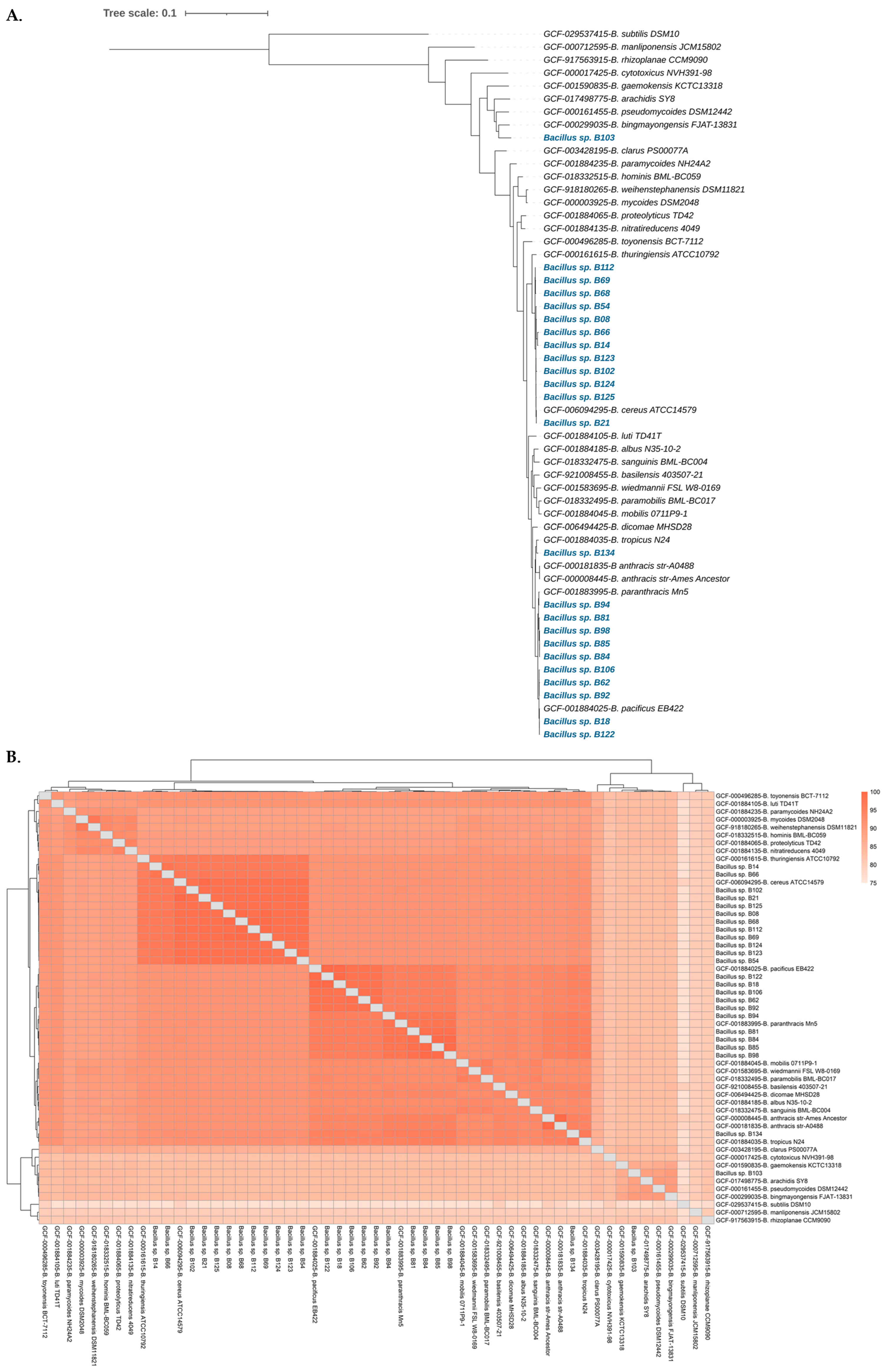
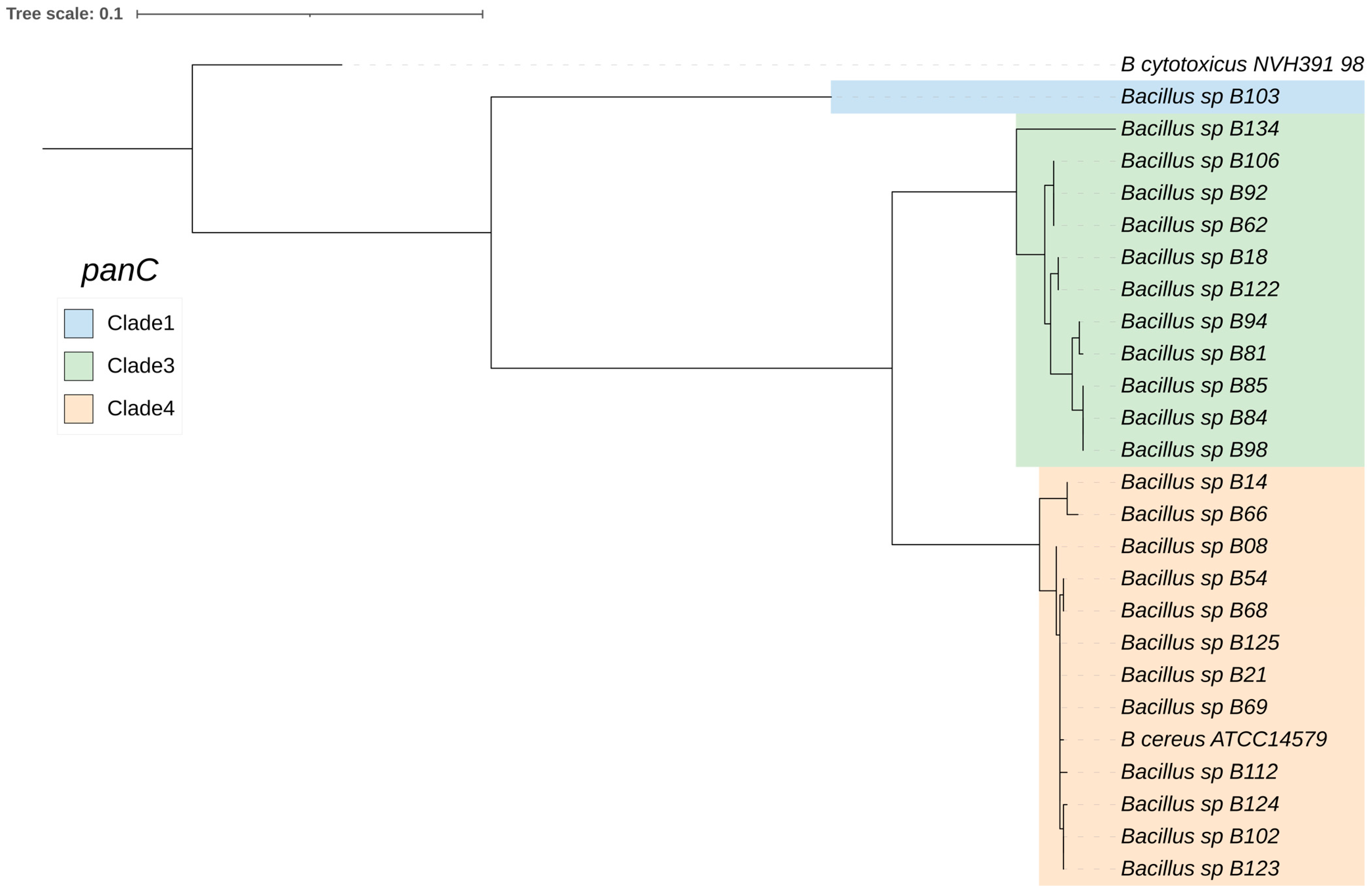
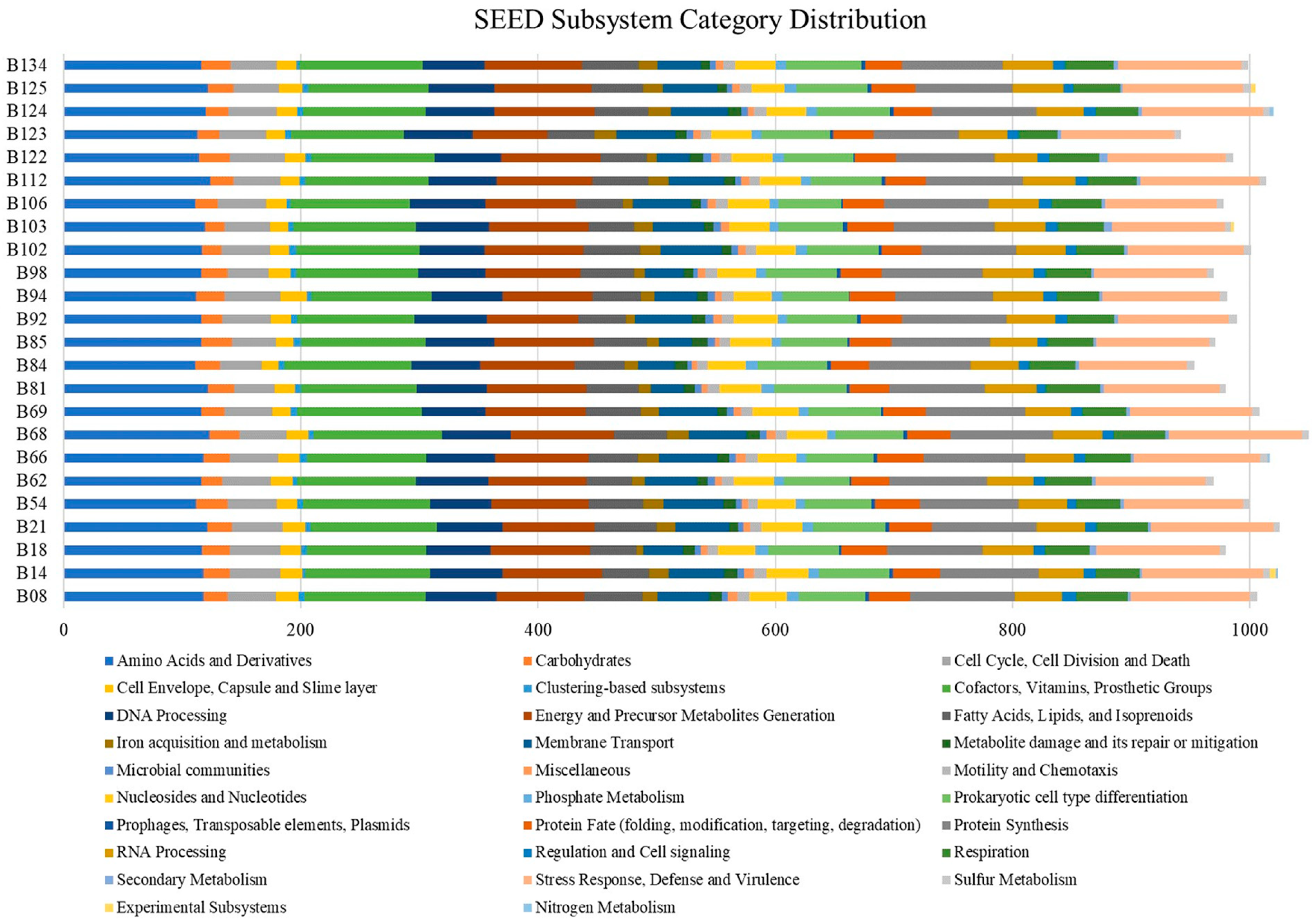

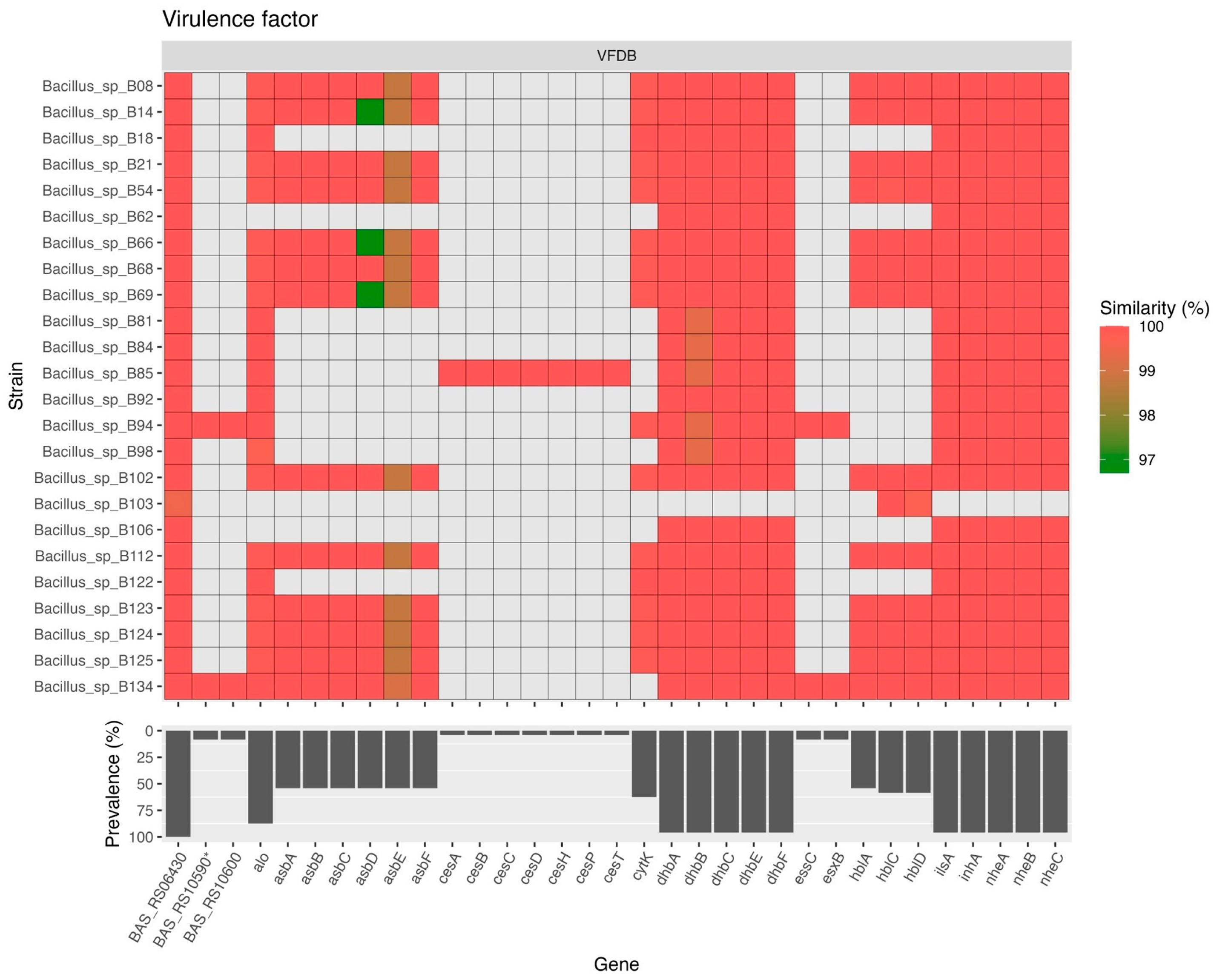
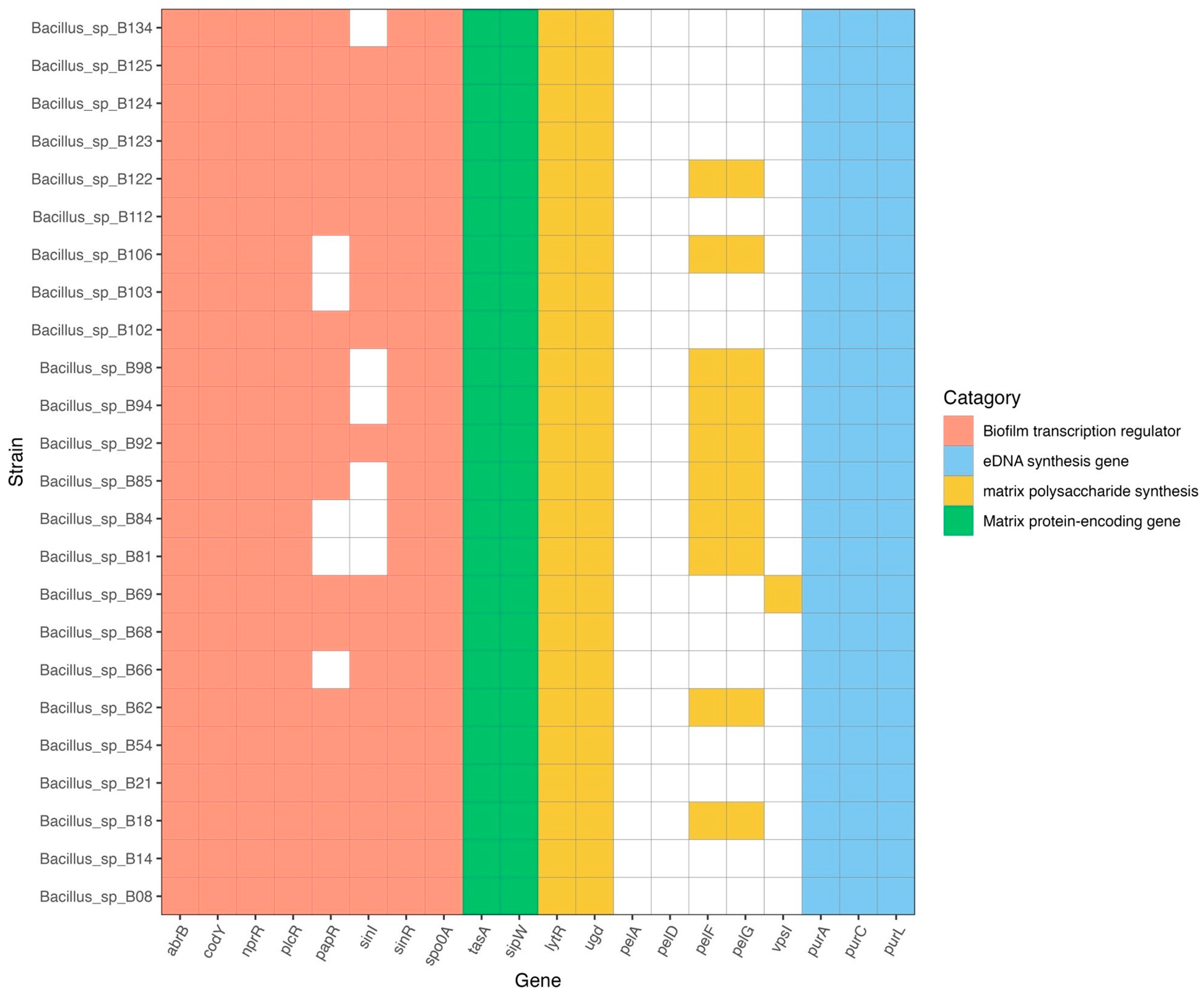
| Strain Names | Source | BioSample Accession | Closest species (ANI%) | Coverage | Contig (s) | Size (bp) | GC% | CDS |
|---|---|---|---|---|---|---|---|---|
| B08 | spicy green papaya salad with bamboo shoot | SAMN37915793 | B. cereus (98.84%) | 78.2× | 39 | 5,344,844 | 35.06 | 5371 |
| B14 | clear soup with tofu and minced pork | SAMN37915794 | B. cereus (96.86%) | 57.8× | 258 | 6,378,095 | 34.66 | 6524 |
| B18 | stir-fried mixed vegetables | SAMN37915795 | B. pacificus (99.92%) | 74.1× | 55 | 5,453,845 | 35.27 | 5571 |
| B21 | stir-fried pumpkin | SAMN37915796 | B. cereus (99.85%) | 81.8× | 30 | 5,262,391 | 35.04 | 5292 |
| B54 | stir-fried noodle with yentafo sauce | SAMN37915797 | B. cereus (98.67%) | 68.4× | 34 | 5,880,551 | 34.80 | 5970 |
| B62 | rice with spicy shrimp paste dip and fried mackerel | SAMN37915798 | B. pacificus (98.12%) | 72.5× | 145 | 5,542,779 | 35.17 | 5703 |
| B66 | stir-fried noodle | SAMN37915799 | B. cereus (96.98%) | 61.4× | 104 | 6,152,935 | 34.76 | 6074 |
| B68 | stir-fried mixed vegetables | SAMN37915800 | B. cereus (98.75%) | 73.1× | 65 | 5,951,707 | 35.01 | 6082 |
| B69 | spicy mixed vegetable soup | SAMN37915801 | B. cereus (98.90%) | 71.7× | 43 | 5,378,133 | 35.01 | 5376 |
| B81 | spicy Vietnamese pork sausage salad | SAMN37915802 | B. paranthracis (97.80%) | 73.4× | 44 | 5,223,900 | 35.35 | 5287 |
| B84 | spicy tremella mushroom salad | SAMN37915803 | B. paranthracis (97.68%) | 80.9× | 52 | 5,126,336 | 35.34 | 5169 |
| B85 | spicy pork meatball salad | SAMN37915804 | B. paranthracis (97.54%) | 77.9× | 78 | 5,473,500 | 35.25 | 5546 |
| B92 | sushi | SAMN37915805 | B. pacificus (98.14%) | 70.9× | 100 | 5,528,812 | 35.31 | 5660 |
| B94 | spicy fermented fish dip | SAMN37915806 | B. paranthracis (98.52%) | 66.2× | 60 | 5,435,642 | 35.15 | 5496 |
| B98 | stir-fried glass noodles | SAMN37915807 | B. paranthracis (97.53%) | 157.5× | 97 | 5,426,062 | 35.17 | 5512 |
| B102 | sandwich | SAMN37915808 | B. cereus (98.47%) | 188.0× | 37 | 5,221,584 | 35.08 | 5237 |
| B103 | salad roll with crab stick | SAMN37915809 | “B. bingmayongensis” (90.05%) | 181.6× | 64 | 5,437,995 | 35.50 | 5436 |
| B106 | stir-fried lotus stem and straw mushroom with pork | SAMN37915810 | B. pacificus (98.18%) | 76.8× | 70 | 5,401,240 | 35.18 | 5541 |
| B112 | stir-fried tofu with bean sprouts | SAMN37915811 | B. cereus (98.87%) | 122.2× | 127 | 5,712,866 | 35.05 | 5773 |
| B122 | stir-fried pickled turnip with egg | SAMN37915812 | B. pacificus (99.95%) | 64.5× | 61 | 5,431,860 | 35.27 | 5487 |
| B123 | stir-fried zucchini with egg | SAMN37915813 | B. cereus (98.85%) | 66.2× | 47 | 5,481,273 | 34.87 | 5454 |
| B124 | egg noodles with roasted red pork and wonton | SAMN37915814 | B. cereus (98.89%) | 89.7× | 58 | 5,856,371 | 34.76 | 5803 |
| B125 | Thai rice noodle salad roll | SAMN37915815 | B. cereus (98.85%) | 84.3× | 27 | 5,631,595 | 34.92 | 5647 |
| B134 | stewed pork leg on rice | SAMN37915816 | B. tropicus (96.87%) | 47.7× | 38 | 5,208,045 | 35.24 | 5239 |
Disclaimer/Publisher’s Note: The statements, opinions and data contained in all publications are solely those of the individual author(s) and contributor(s) and not of MDPI and/or the editor(s). MDPI and/or the editor(s) disclaim responsibility for any injury to people or property resulting from any ideas, methods, instructions or products referred to in the content. |
© 2024 by the authors. Licensee MDPI, Basel, Switzerland. This article is an open access article distributed under the terms and conditions of the Creative Commons Attribution (CC BY) license (https://creativecommons.org/licenses/by/4.0/).
Share and Cite
Sornchuer, P.; Saninjuk, K.; Amonyingcharoen, S.; Ruangtong, J.; Thongsepee, N.; Martviset, P.; Chantree, P.; Sangpairoj, K. Whole Genome Sequencing Reveals Antimicrobial Resistance and Virulence Genes of Both Pathogenic and Non-Pathogenic B. cereus Group Isolates from Foodstuffs in Thailand. Antibiotics 2024, 13, 245. https://doi.org/10.3390/antibiotics13030245
Sornchuer P, Saninjuk K, Amonyingcharoen S, Ruangtong J, Thongsepee N, Martviset P, Chantree P, Sangpairoj K. Whole Genome Sequencing Reveals Antimicrobial Resistance and Virulence Genes of Both Pathogenic and Non-Pathogenic B. cereus Group Isolates from Foodstuffs in Thailand. Antibiotics. 2024; 13(3):245. https://doi.org/10.3390/antibiotics13030245
Chicago/Turabian StyleSornchuer, Phornphan, Kritsakorn Saninjuk, Sumet Amonyingcharoen, Jittiporn Ruangtong, Nattaya Thongsepee, Pongsakorn Martviset, Pathanin Chantree, and Kant Sangpairoj. 2024. "Whole Genome Sequencing Reveals Antimicrobial Resistance and Virulence Genes of Both Pathogenic and Non-Pathogenic B. cereus Group Isolates from Foodstuffs in Thailand" Antibiotics 13, no. 3: 245. https://doi.org/10.3390/antibiotics13030245
APA StyleSornchuer, P., Saninjuk, K., Amonyingcharoen, S., Ruangtong, J., Thongsepee, N., Martviset, P., Chantree, P., & Sangpairoj, K. (2024). Whole Genome Sequencing Reveals Antimicrobial Resistance and Virulence Genes of Both Pathogenic and Non-Pathogenic B. cereus Group Isolates from Foodstuffs in Thailand. Antibiotics, 13(3), 245. https://doi.org/10.3390/antibiotics13030245









